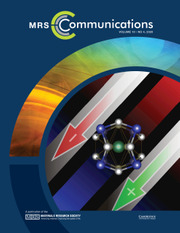Article contents
Dislocation dynamics study of precipitate hardening in Al–Mg–Si alloys with input from experimental characterization
Published online by Cambridge University Press: 04 September 2017
Abstract

Partial aging of AA6060 aluminum alloys is known to result in a microstructure characterized by needle-shaped Si/Mg-rich precipitates. These precipitates belong to the non-equilibrium β″ phase and are coherent with the face-centered cubic Al lattice, despite of which they can cause considerable hardening. We have investigated the interaction between these β″ precipitates and dislocations using a unique combination of modeling and experimental observations. Dislocation-precipitate interactions are simulated using dislocation dynamics (DD) parameterized with atomistic simulations. The elastic fields due to the precipitates are described by a decay law fitted to high-resolution transmission electron microscopy measurements. These fields are subsequently used in DD to study the strength of individual precipitates as a function of size and dislocation character. Our results can be used to parameterize crystal plasticity models to calculate the strength of AA6060 at the macroscopic level.
Information
- Type
- Research Letters
- Information
- Copyright
- Copyright © Materials Research Society 2017
References
- 10
- Cited by

